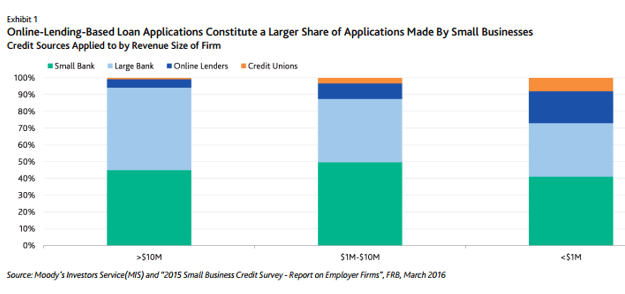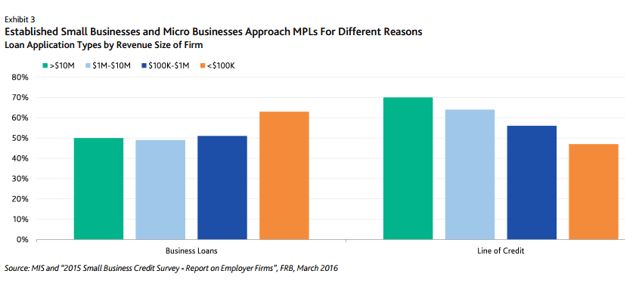
Marketplace Lenders (MPLs) can offer several potential benefits to small businesses, including reduced application times and expanded access to credit for less-established businesses. MPLs’ partnerships with banks can also be mutually beneficial, allowing MPLs to achieve higher volumes while offering lower rates and allowing banks to expand existing relationships. Despite the potential economic benefits, however, several challenges -- especially regulatory and loan performance uncertainty -- could stymie the growth of bank and small business MPLs’ partnerships.
MPLs Are Steadily Expanding Credit for SMEs
The number of MPLs serving the U.S. small business community has increased steadily since the financial crisis. Although online lenders still provide a relatively small share of overall lending to SMEs, as the exhibit below shows they are a much more important source of funding for small businesses compared to larger companies.

The 2015 Small Business Credit Survey, conducted by the Federal Reserve, revealed that most small businesses who borrow from MPLs fall into two main categories:
- Micro-businesses, which we define in this article as small businesses with less than $1 million in revenues, and
- Established small businesses, which we define as small businesses with greater than $1 million in revenues.
Each of these borrower categories have slightly different borrowing needs that MPLs meet.
Micro-businesses are often constrained by the lack of credit history
Insufficient credit history is a leading impediment to obtaining funding for micro-businesses, and drives a larger proportion of such borrowers to small business MPLs relative to larger firms. This contrasts with firms that have more than $1M in revenues, which are generally more mature and have had time to establish a credit history.
Difficulties in obtaining funding due to insufficient credit history or collateral is more often a constraint when borrowing from banks, who are often themselves constrained by internal policies that limit exposure to such borrowers. This would naturally lead to a higher fraction of online loan applications made by small businesses, which is what we observe in Exhibit 1 - while bank loan applications constitute the majority of loan applications across all small businesses, online-lending-based applications constitute a larger share of the applications made by micro-businesses.
Established small businesses often approach MPLs to meet short-term liquidity needs
Established small businesses more often have existing banking relationships and approach MPLs either when their credit histories are deemed too weak for banks to lend to, or when they have immediate liquidity needs and bank application and approval processes are not fast enough to address their immediate needs. As the exhibit that follows shows, established small businesses show a greater demand for lines of credit (LOCs) relative to micro businesses -- a loan product that is primarily designed to meet short-term liquidity needs.

Small Business MPLs Charge High Interest Rates Partly Due to High Customer Acquisition and Funding Costs
Although small borrowers are able to secure funds from MPLs, they are often unhappy about the high borrowing rates. The U.S. Treasury survey showed that marketplace borrowers had the lowest lender satisfaction scores amongst MPLs, large and small banks, and credit unions. A vast majority of dissatisfied borrowers, roughly 70%, cited the high interest rates at MPLs as the reason for dissatisfaction -- compared with 15% and 18% at small and large banks respectively. As an example, OnDeck reported in its 10-K filing with the SEC that its weighted average APR for term loans and lines of credit was roughly 41% in Q4 2015.
The high lending rates at small business MPLs reflect the high credit risk; however, high sales and marketing customer acquisition expenses and high costs of funding are some of the non-credit reasons for why lending rates at small business MPLs are high.
Relationships with Banks and Other Funding Organizations Can Reduce Acquisition Costs and Funding Costs
To attract a larger borrower base, MPLs have been looking at ways to improve the efficiency of their customer acquisition process, as well as capital funding. One of the avenues MPLs are pursuing is establishing partnerships with banks: recent examples of relationships between small business MPLs and banks include OnDeck and BBVA and OnDeck and JP Morgan.
Relationships with banks help reduce customer acquisition cost by rebalancing the channel mix
Customer acquisition costs are a major expense for small business MPLs, averaging roughly 25% of revenues at some of the largest small business MPLs like OnDeck. Since customer acquisition costs vary by channel, with indirect channels (e.g., 3rd-party brokers) generally costing more than direct channels (e.g., online advertising, mail, strategic partner referrals), lenders like OnDeck have focused on increasing the share of direct channel customer acquisitions by building strategic relationships with banks. These relationships allow MPLs to leverage existing relationships between banks and SMEs such as existing retail lending or existing retail or commercial deposit relationships, and allow small business MPLs to lower their acquisitions costs.
Relationship with banks can reduce funding costs for small business borrowers as well as provide the MPL with a more stable funding source
Finding a reliable and low-cost source of funding has also been a challenge for small business MPLs who have used a variety of strategies to fund their loans. These include funding loans through fractional interests with retail investors, directly with institutional investors accessing the securitization market as well as through their own access to funding.
The recently initiated OnDeck-JP Morgan partnership is an example of ways in which banks and small business MPLs can form partnerships to lend to small businesses. Under the OnDeck-JP Morgan relationship, small businesses are first pre-approved as clients to whom Chase is willing to lend to, even though specific loans have not been approved. Pre-approved borrowers can apply for loans of up to $250,000 using the OnDeck technology platform, with approved borrowers funded by JP Morgan:
- Small business borrowers benefit from the expediency of an MPL’s technology platform, along with what we expect are lower rates than offered by standalone MPLs (due to the lower acquisition costs as well as JP Morgan's low funding costs).
- OnDeck benefits from higher origination volumes, lower customer acquisition costs, and a more stable funding source.
- The bank benefits from a faster loan review and approval process and by keeping as well as expanding its existing relationships
Small Business MPLs Will Continue to Build Other Alliances to Lend to Small Businesses, Especially Micro-Borrowers
Despite its potential benefits, the OnDeck-JP Morgan partnership likely does not address the lending needs of micro-borrowers, an important borrowing group for MPLs. Micro-businesses, which lack the credit histories to obtain funding from banks, are largely unable to benefit from such relationships.
We expect small business MPLs to continue to serve these businesses through other avenues, including forming alliances with nonbanks. We believe that regardless of the eventual outcome of the OnDeck-JP Morgan partnership, MPLs will continue to seek and build other third-party partnerships in order to expand their funding and lend to micro-businesses, as well as reduce acquisitions costs and increase origination volumes through referral agreements.
Model Risk and Evolving Regulatory Landscape Can Still Stymie These Nascent Partnerships
Despite the potential economic benefits, several challenges, especially regulatory and loan performance uncertainty, could stymie the growth of bank and small business MPLs’ partnerships.
OnDeck’s quantitative model-based ability to accurately assess credit risk through a credit downturn is still unproven. The lender has been in existence since before the crisis -- the company was founded in 2006 and the first loans were issued in 2007. However, roughly 90% of its $4 billion of loans have been originated since 2013. Additionally, there is regulatory uncertainty that hangs over the small business marketplace lending space, which could adversely affect such partnerships.
Small businesses lending is subject to less regulation compared to consumer lending; however, there is a risk that lending to small businesses might be grouped under consumer lending and become subject to greater regulatory scrutiny. Certain states have already begun to take steps to regulate small business MPLs. For example, state regulators in Illinois, New York and California have announced that they are exploring ways to place greater restrictions on small business marketplace lending practices. These restrictions include requiring greater transparency and disclosure around lending rates, prohibiting MPLs from using more than 50% of a borrower’s net cash revenues as a source of repayment, and making lenders liable for representations made by their brokers to borrowers. While such efforts are still in their initial stages, we believe they speak to the likelihood of greater disclosure requirements and possible greater regulatory scrutiny over the small business marketplace lending space.
Small Business MPLs That Go at It Alone Face Adverse Selection Challenge
As discussed above, established small businesses often have existing banking relationships and tend to approach MPLs either when their business performance history is weak and reduces their access to bank funding, or when they are in need of immediate liquidity and banks cannot approve their loan quickly. Bank’s indigenous lending technology solutions are likely to cater to SME’s immediate liquidity needs, in addition to regular funding needs. As a result, small businesses that approach MPLs outside of banking partnerships are likely to consist more and more of borrowers with poor credit histories. This raises the risks of adverse selection for small business MPLs that lend outside of the partnership model, particularly if this model is increasingly adopted.